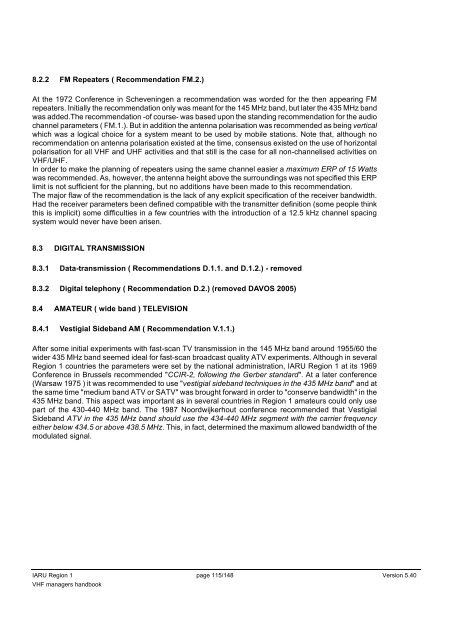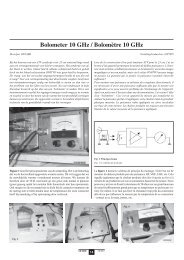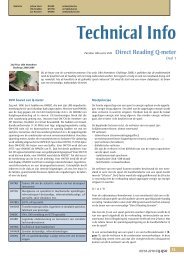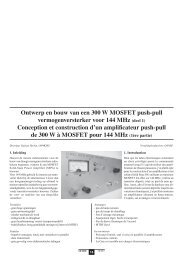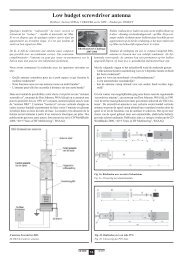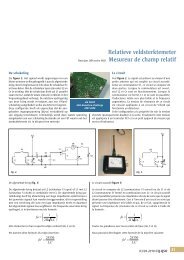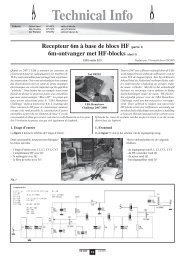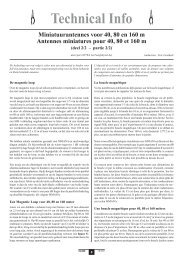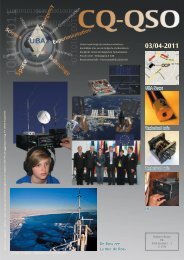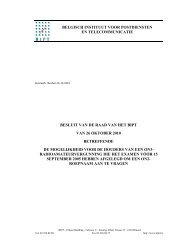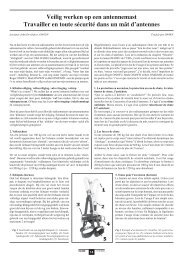IARU Region 1 VHF Managers Handbook - UBA
IARU Region 1 VHF Managers Handbook - UBA
IARU Region 1 VHF Managers Handbook - UBA
Create successful ePaper yourself
Turn your PDF publications into a flip-book with our unique Google optimized e-Paper software.
8.2.2 FM Repeaters ( Recommendation FM.2.)<br />
At the 1972 Conference in Scheveningen a recommendation was worded for the then appearing FM<br />
repeaters. Initially the recommendation only was meant for the 145 MHz band, but later the 435 MHz band<br />
was added.The recommendation -of course- was based upon the standing recommendation for the audio<br />
channel parameters ( FM.1.). But in addition the antenna polarisation was recommended as being vertical<br />
which was a logical choice for a system meant to be used by mobile stations. Note that, although no<br />
recommendation on antenna polarisation existed at the time, consensus existed on the use of horizontal<br />
polarisation for all <strong>VHF</strong> and UHF activities and that still is the case for all non-channelised activities on<br />
<strong>VHF</strong>/UHF.<br />
In order to make the planning of repeaters using the same channel easier a maximum ERP of 15 Watts<br />
was recommended. As, however, the antenna height above the surroundings was not specified this ERP<br />
limit is not sufficient for the planning, but no additions have been made to this recommendation.<br />
The major flaw of the recommendation is the lack of any explicit specification of the receiver bandwidth.<br />
Had the receiver parameters been defined compatible with the transmitter definition (some people think<br />
this is implicit) some difficulties in a few countries with the introduction of a 12.5 kHz channel spacing<br />
system would never have been arisen.<br />
8.3 DIGITAL TRANSMISSION<br />
8.3.1 Data-transmission ( Recommendations D.1.1. and D.1.2.) - removed<br />
8.3.2 Digital telephony ( Recommendation D.2.) (removed DAVOS 2005)<br />
8.4 AMATEUR ( wide band ) TELEVISION<br />
8.4.1 Vestigial Sideband AM ( Recommendation V.1.1.)<br />
After some initial experiments with fast-scan TV transmission in the 145 MHz band around 1955/60 the<br />
wider 435 MHz band seemed ideal for fast-scan broadcast quality ATV experiments. Although in several<br />
<strong>Region</strong> 1 countries the parameters were set by the national administration, <strong>IARU</strong> <strong>Region</strong> 1 at its 1969<br />
Conference in Brussels recommended "CCIR-2, following the Gerber standard". At a later conference<br />
(Warsaw 1975 ) it was recommended to use "vestigial sideband techniques in the 435 MHz band" and at<br />
the same time "medium band ATV or SATV" was brought forward in order to "conserve bandwidth" in the<br />
435 MHz band. This aspect was important as in several countries in <strong>Region</strong> 1 amateurs could only use<br />
part of the 430-440 MHz band. The 1987 Noordwijkerhout conference recommended that Vestigial<br />
Sideband ATV in the 435 MHz band should use the 434-440 MHz segment with the carrier frequency<br />
either below 434.5 or above 438.5 MHz. This, in fact, determined the maximum allowed bandwidth of the<br />
modulated signal.<br />
<strong>IARU</strong> <strong>Region</strong> 1 page 115/148 Version 5.40<br />
<strong>VHF</strong> managers handbook


